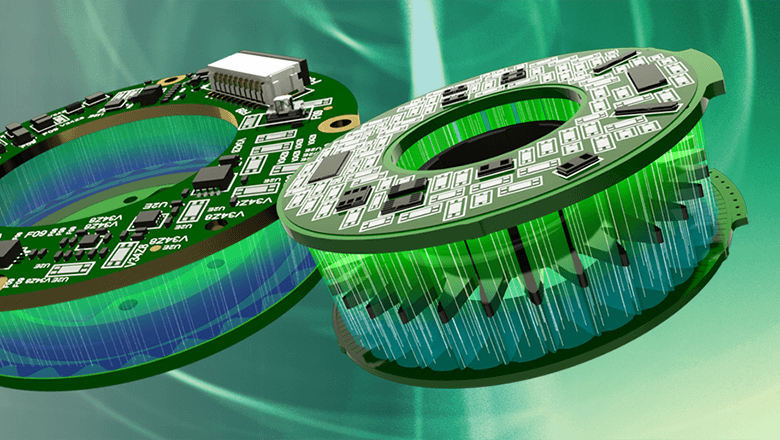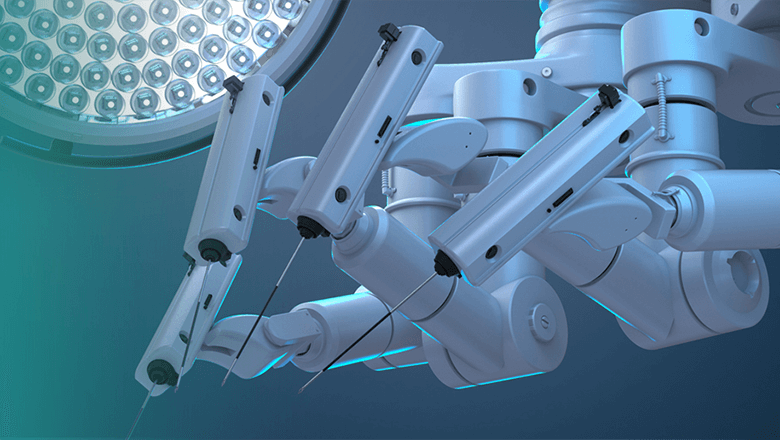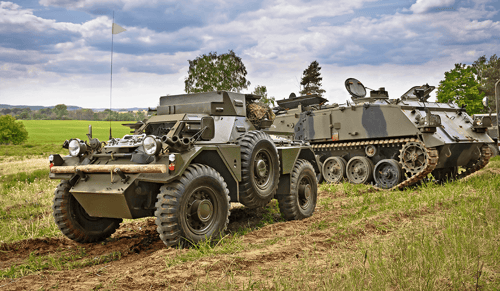Measuring angular rotation with an absolute rotary encoder

Absolute rotary encoders, or angular rotation sensors, measure the angular rotations of a machine’s shaft. They measure the absolute angle from the start-up. This capacitive encoder is known for its high resolution, compact design and low weight, and it’s extremely robust. Even if you want to integrate this encoder near a motor, with strong magnetic fields, it’s an excellent choice.
Increasingly better performance in a more compact design — this ambition undoubtedly sounds familiar to you, as an engineer. Certainly in applications where weight (inertia), size, accuracy and reliability play an important role. How do you approach that? It starts with the selection of the right components, even when it comes to your choice of encoder.
The development of encoders also reflects this same ambition. For example, absolute rotary encoders are becoming ever more accurate, smaller and lighter. These properties make the encoders exceptionally suitable for integration. After reading this article, you’ll know more about the operation of this capacitive encoder and the possibilities it offers.
Absolute angular rotation sensors
Absolute rotary encoders are also called angular rotation sensors. They measure the angle of rotation, from 0 to 360 degrees. Because this encoder is absolute, the sensor always measures the correct angle directly after starting up. Even if the shaft is rotated while no voltage is present on the sensor, the encoder immediately knows the angle after starting up again.
How does an absolute rotary encoder work?
How an absolute rotary encoder works depends on the operational principle. For example, there are encoders on the market that work by induction, magnetism, capacitance and light.
The absolute rotary encoders from our partner Netzer work on the basis of a change in capacitance. This type of sensor consists of multiple plates, with one plate fixed and the other plate — with unique coding — attached to a rotating part. These plates revolve relative to each other without making contact.
Sean Ram, Account Manager at Sentech, explains: “Between these plates is an electric field. If the target plate rotates, this field will be influenced. That’s how the encoder measures how many degrees the shaft has rotated.”
David Reuijl, R&D Engineer at Sentech, adds: “Because the coding on the encoder plate is unique, the system registers the exact angle. Even when the shaft is rotated without the encoder receiving any voltage. Furthermore, this type of encoder communicates according to the widely used BISS-C and SSI protocols.”
5 advantages of absolute rotary encoders
Which technology suits your measuring requirement? This depends in part on the desired resolution and the accuracy. Sometimes the size and the weight or inertia of the component play a large role, such as with light constructions and high accelerations. Engineers select an absolute rotary encoder based on the following advantages.
-
High resolution
The absolute rotary encoders from Netzer measure to 21 bits. Converted to degrees, this amounts to a step size of 0.00017 degrees.
-
Compact design
There are models of these capacitive encoders on the market with an extremely compact design. For example, they are available in thicknesses to 7 mm. And they are compact, even in terms of the outer diameter. For example, they are available in measurements varying from 16 mm to 130 mm in diameter. In addition, all variants are produced as a hollow-shaft encoder. This enables cables to be run through the heart of the encoder.
-
Low weight and low inertia
The housing of the encoders is made from plastic and therefore has a low weight. The encoders of Netzer’s VLX line even have no housing at all. This limits their weight even more and enables them to be integrated even more compactly.
-
Long service life
Because the components in this type of encoder move contactlessly relative to each other, no wear and tear takes place. This ensures a long service life.
-
Insensitivity to dust and magnetism
If you want to measure a rotation in a robot, there are likely to be electric motors nearby. These motors generate high-frequency magnetic fields with large amplitudes. An absolute rotary encoder is insensitive to these electromagnetic fields, which makes this solution suitable even for installation near motors. This type of encoder is also impervious to contamination with dust.

Applications
Absolute rotary encoders are suitable for applications in which you want to measure an absolute rotation. With their high degree of accuracy, these encoders are often found in machines in high-tech industries and robotics. But this technology can also provide an appropriate solution for automated guided vehicles (AGVs) and horticulture.
Did you know, for example, that absolute encoders can be effectively used in combination with brushless DC motors?
Absolute angle measurement in brushless DC motors
Brushless DC motors are often used in new machines. These newer motors are difficult to control if you don’t know what the position of the spool is compared to the magnets. For this type of motor, therefore, you must measure the absolute angle. This angle is needed when starting up for the correct control of the motor.
“With older types of brushed DC motors, no encoder was necessary for the control when starting up. Nowadays, the demand for the newer brushless DC motors has grown. After all, they have a higher power density. And they also require less maintenance due to the absence of mechanical means to control the power through the coils,” according to Reuijl.
Ram adds, “Increasingly, customers want to integrate an absolute encoder in their application. With the hollow shaft encoders from Netzer, it’s possible to place a highly accurate encoder in a very limited space. At the same time, this encoder also offers a solution for simple calibration and wiring access.”
Hollow-shaft encoder in robotics
In robotics applications such as robot arms, there are many moving and rotating parts. If the robot arm can rotate more than 360 degrees, it’s certainly handy to have the cables run through the middle of the encoder.
The capacitive absolute rotary encoders are constructed as hollow-shaft encoders. By running the cables through the middle of the encoder, you avoid having to use expensive robot cables around error-prone sliding contacts.
How do you select the right technology for you?
If you want to measure a rotation precisely and in a contactless manner, the absolute rotary encoder could be what you’re looking for. Even without ‘homing,’ or if you want to control a BLDC motor. And certainly if your application also requires a solution for cable access.
In addition to the above considerations, there is a wide range of criteria that determine which technology best fits your application.
We have created a list of the selection criteria for you. These 10 selection questions will help you on your way to selecting the right encoder for your application.


.png)

